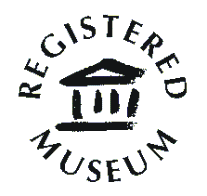

Newsletter
Issue 57 February 2007


~~~ NEWSDESK ~~~
Table of contents
Newsdesk, and dates for your diary 2
Museum Update - 4
Curator 4
Ravensbury 4
HLF 5
Other 7
Merton Abbey Mills update 8
Wandle Valley Festival update 9
A Spotters Guide to R. Wandle Wildlife 9
Dan Jenner bicycles 10
Glimpse of the Past (Huguenots) 13
Museum Closures 14
Newsdesk
Visits to the Museum There have been no group visits to the Museum since Christmas, but several visitors on Wednesdays and Sundays have enjoyed visiting us and left appreciative comments in our Visitors Book:
• Very interesting — a jewel of a Museum
• We will be here again soon
• A great discovery!
• Full of fascinating local history. Thank you!
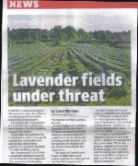
Volunteers A very successful Quarterly Volunteers Meeting was held on 31st January at which 17 volunteers were present and once again enjoyed an excellent lunch which was kindly provided by Mary Hart. After the Meeting leaflets and posters about the possible closure of Wandsworth Museum were passed around and discussed, and all members signed a petition to Wandsworth Council protesting about this proposal.
This is a bad time for Museums at the moment. Not only is the Wandsworth Museum under threat but also the William Morris Gallery in Walthamstow, and the Carshalton Lavender Fields might be lost in the rebuilding of Stanley Park High School in the London Borough of Sutton.
We shall be having a stall- at the Volunteer Recruitment Fair in the Vestry Hall on March 7th.
Members' Events The Christmas Party was a great success; once again with a great selection of Christmas delicacies provided by Mary.
Members of the Management Committee were pleased to be invited to a Reception at the Mayor's Parlour in mid-January. The Mayor, Cllr Geraldine Stanford, had invited members from several heritage groups all connected with the River Wandle. We were happy to chat to members of Wandle Heritage Ltd who run The Wheelhouse at Merton Abbey Mills, plus John Hawks the Market Manager, and Norman Fairey, one of our members also connected with Abbey Mills.

Museum member Mr W.W.Hill has suggested a future visit to the House Mill at Bromley-by-Bow, where he is a volunteer. The Mill, which is open to the public by private arrangement, is on the River Lea and was built in 1776 on the site of an earlier mill. It has been substantially restored since 1989 and the Miller's House fitted out as a Visitor and Education Centre.
It is accessible by Tube. The District Line will take you to Bromley-by-Bow from which it is a short walk. Entry fee is £3 per person and a lift is available to take you to the four floors open to the public. There is a small cafe selling teas and snacks. A private group visit could be arranged any day Monday-Saturday. Please ring the Museum on 020 8648 0127 or e-mail curator@wandle.org if you are interested in this visit, then a date in Spring/Summer could be arranged.
Dates for your Diary
At the time of writing we are not sure whether we shall be having a stall at the National Trust Fair in Morden Hall Park — May 5th, 6th and 7th. Information regarding this will be sent out nearer the time.
The Opening of the new Exhibition about Young's Brewery will be on Saturday 16th June. Invitations will be sent out at a later date.
Wimbledon Village Fair will take place on Saturday June 23rd and help would be much appreciated at this fund-raising event.
The Museum will be open for the Wandle Valley Festival on Sunday June 24th and there will be many Wandle-related events in the area.
Annual Subscriptions A membership renewal form is included for those who have not yet paid their subscription for 2007.
Sheila Harris 21 February 2007
Museum Update
New Exhibition June 16 2007
Curators Report
The new display will be about Young's Brewery. The brewery has now left its Wandsworth site, which has been bought by a company called Minerva.
As part of the preparation for the display Eric and I visited the Wandsworth site. We met the archivist, Denis Reed, who we hope will be able to lend us some material for the display.
We were very fortunate to meet one of the brewers John Hatch and he took us on a tour of the brewery. Although John was clearly saddened by the closure of the Wandsworth site he was encouraged by the attitude of the new owners, who are very excited at the prospect of owning one the oldest brewery's in England.
English Heritage have gone over the site with a fine tooth comb and much of the brewing equipment has been listed. The items listed include the two Woolf compound beam engines built by Wentworth of Wandsworth.
They are the only Woolf beam engines still working.
Although most of the horses have left the site there were two still in the
stable and with them two donkeys. Why two donkeys, you'll have to
visit the display to find out.
Meg Thomas, February 2007
Ravensbury Mill
Although at time of writing our follow up meeting with LB Merton has not yet happened, at the meeting in January Councillor Maurice Groves, who has Cabinet responsibility for us, promised to visit all the officers responsible for ensuring final completion of the works at Ravensbury personally, and seek to understand exactly how and when they will be able to force closure on this long outstanding point. We look forward to our further meeting with Ingrid and Maurice, when he can report on his findings.
To us it seems very simple, but LA procedures have to be followed. It is a matter of great sorrow to learn from Maurice and Ingrid Lackajis of the many

meetings, and copious exchanges of emails, that we have apparently inflicted on the officers at LBM, at a time when they have so many important matters on their collective plates, not least those arising from a change in the leadership of the Council, and the budget deficits they are facing.
There must surely come a time when bodies such as ours can have direct access to the relevant officers, especially in the legal section. Not only will this cut out levels of duplicated communication within the Council, but will much reduce the possibilities of misinterpretation along the way.
HLF
On a similar point, our follow up meeting with LBM on the proposed HLF grant has had to be postponed, as complications have arisen. Ingrid has assured us this matter will not be dropped, but she wants to master her brief on this fully so that the next meeting can be productive.
You will probably recall from previous articles that we have a sticking point in our HLF application plan. Relatively recently HLF has required the ability to take a charge on the physical assets of a body to whom a grant has been given, so that they can enforce repayment of that money if grant conditions are broken.
Our proposed lease of Ravensbury (which follows the s106 agreement in this respect) does not allow this.
Despite that, HLF have suggested a work round that merely requires LBM to consult with them should, as a result of our deciding to give up Ravensbury for financial reasons, for example. That document will, eventually, need approval at Council level (full or Cabinet), but Ingrid assures me that there is no reason why we can not proceed on the assumption consent will be forthcoming.
On that basis, I had a catch up meeting with HLF last week. From that meeting (on which I will be reporting fully to the management Committee next week) it is clear we will be facing a new choice, soon. The present structure of HLF major grants assumes a two stage process, where even the first stage requires extensive investment in time and expertise to reach application stage, let alone be sure of being awarded a grant. To cover this, a Project Planning Grant process was instituted. This is to fund the reports and research needed to make the stage 1 bid.
Initially, the PPG application was relatively simple. Over the years it has become more and more paper intensive itself, with significant elements of chicken and egg built in.
HLF have listened to criticism on the size of these hurdles, and, from April 2008, the PPG will be dropped, and replaced by a much simpler approach to a Stage 1 bid.
The Management Committee will have to decide whether we push through a PPG bid this year (assuming other matters to do with the lease and s106 fall into place), or deliberately plan a 2008 bid so we can get in on the first rush for the new Stage 1 before it, too, starts the inevitable progress back to complexity.
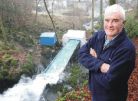
Bel Mickle Hydro
Whatever happens, our approach to the new museum is likely to be much different. In the 10 years since we first started preparing plans, the largely static displays then proposed will give way to much more interactive material, using modern technology, and at the same time a greater emphasis on the hands on elements of the block printing demonstrations we currently deliver, expanded to the other processes the increased room will allow.
The move to alternative power sources will undoubtedly play a part, whether by installation of battery storage as at the Wheelhouse, to deliver lighting etc. from the normal workings of the water wheels, or by installation of the newer an more efficient schemes for selling electricity to the National Grid.
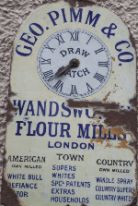
Draw batch clock
As an example of this Ray Leyden found an article about the Bel Mickle Hydro scheme, which promises much improved power from shallower sources, see image. I strongly recommend a visit to the various articles on the web for those interested in these things. Why is this relevant to us? At Ravensbury a slot has been cut into the sluices to allow a permanent flow of water through the millpond, which was otherwise silting up, and become unhealthily stagnant. Although a crime against its English Heritage listing, a grant would enable us to channel that water much more efficiently, and productively, if the technology exists to harness such a shallow sluice. 10 years ago nothing existed like this. Today, it seems, it does.
Electronic News
Serendipity has brought three web related items to us in the last couple of weeks.
From New Zealand we hear of Peter Russell, now in his 90's, whose family worked Ravensbury Mill, then known as Rutters Snuff Mill, until the 1920's. Peter McGow’s pages on this mill on our website have given him much pleasure, and he has promised us some oral history, recalling the mill as he remembers is as a child in Morden.
Then we heard from John Weller, a scion of the Pimm family, who came across reference to the draw batch clock (Newsletter 50, may 05). Again, personal history from him, and, in return, our pointing him at McGow (the Pimm family are connected to mills 45,48 and 49) filled in many gaps for him.
Finally, John Barringer got in touch, and has supplied us with his article about Dan Jenner and his top of the range cycles manufactured for many years in Merton/Colliers Wood. An extract is published on page 10 below.
Ed. 25 February 2007
Merton Abbey Mills Update
The most noticeable change at MAM is that the new decorated hoardings have now gone up.
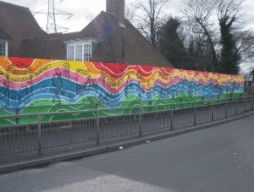
The New Hoarding
The new hoarding
Since the refurbishment of Savacentre resulted in the destruction of the murals that decorated the access, there has been no graphic display which shows the variety of subjects which have MAM at their core.
Once again the new owners of the site have invested money in rectifying this gap.
The new hoardings are colourful, and sit alongside the area where so many cars are forced to wait whilst the pedestrian crossing lights hold up traffic, and are bound to get a good ‘viewing public’ as a result.
The Museum supplied Surrey Iron Railway images for use in the graphics, and last November’s newsletter provided the image of the proposed new windvane.
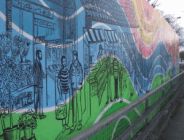
The pictures here show the display in its total length, and extract panels.
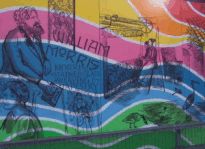
Wandle Valley Festival update
The Wandle Valley festival is on track for 24 June this year, coming on the last weekend of bike week, rather than the first, to avoid clashes.
There will be a large and varied programme in many locations, not least at MAM, where the Chapter House should be open once again.
Booklet
One of the highlights this year is that it has prompted Tony Drakeford (who many of you will know from his wonderful Nature Notes in local newspapers) to create a new booklet on the Wildlife of the Wandle, and donate it to WVF.
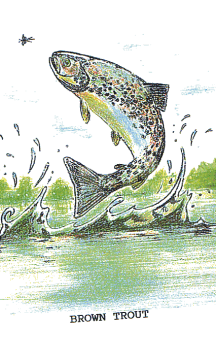
WVF are rushing to get this out and in print for this year’s festival, to enhance the enjoyment of Wandle wanders and provide good resources for all of us into the future. An extract appears below.
“FISH OF THE WANDLE
(from Tony Drakeford’s ‘A Spotters Guide to River Wandle Wildlife’)
Over three hundred years ago Compleat Angler' Isaac Walton often fished the Wandle, well known for its specimen trout.Then gradually, Industrial pollution 'muddied the waters' so to speak and the river declined.In recent years water quality has steadily improved assisted by regular clean ups' by bands of enthusiastic volunteers.Trout are returning, as yet in small numbers perhaps and some have been caught,but a splendid scheme whereby local schools have reared trout fry in the classroom for stocking the Wandle will certainly help, Sea trout may also swim upriver from the Thames and breed in the upper reaches.
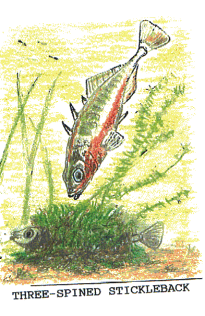
The three-spined Stickleback or 'Tiddler' of childhood days is very common in the Wandle especially in the slower runs. Sticklebacks are the only British species to build a nest. In spring, the male, in breeding finery of red and silver constructs a barrel-shaped nest from pieces of water plant and detritus and entices females to enter and lay eggs.
Upon hatching, the male vigorously guards the young sticklebacks until they can fend for themselves.”
Cycle Builder
Colliers Wood South London
(An Extract)
...
Although the shop was known by all and sundry as “Dan Jenners”, in fact the
name of the business was the XL Cycle Co, and the company logo was
“XLCR”, a play on the word “Excelsior”, meaning very superior. The shop, at
80/98, High Street Colliers wood, was in fact two shops, with a short
passageway between them. Above the shop were two flats, with their own
front doors. The cycle side of the business was mainly carried out in the right
hand shop, viewed from the road, and the glass topped counters displayed all
sorts of accessories. At the back was a workshop, where the hand built bikes
were assembled; A Dan Jenner Bike was a much-coveted item in those days.
What set them apart were the very
thin chain and seat stays and also
the angle of the end of the seat
stay where it met the saddle tube-
it was very oblique. I
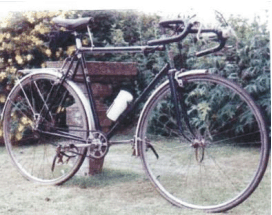
don’t know why, they just looked fast, even when they were stationary.
The down tube had a “Dan Jenner” logo in script style (i.e. not block capitals, but “joined up writing”). I seem to remember that this was hand painted on. The headstock had a metal badge on it with the XL logo. They were made with Reynolds 531 tubing and then custom built.
Gear options were Simplex, Cyclo-Benelux, Huret or Campagnolo, Shimano was a word unheard of then. Anything could be under construction and seen in the shop, track bikes with fixed wheels, sports bikes and touring bikes with up to, but no more than 10 gears, and occasionally a tandem.
They also sold Phillips brand bikes and dealt with the odd second hand bike. My cousin, Doreen, bought a second hand lime green Dan Jenner ladies model, with a four speed Sturmey Archer Hub gear, for £15. The lovely Rosemary Jenner gave me a generous £2 commission/ tip for introducing the sale, I suspect that was most of the shop’s profit, but as already said, she was a kind, generous lady. The other half of the shop was devoted to cycle clothing, Meccano sets and Dinky toys, with the Phillips bikes and second hand bikes for sale displayed in this area.
A gas fire was lit for all of the winter to heat the shop, I used to toast myself in front of it between the shopping errands that I was sent out to do. This involved going to the little grocers shop next door, no supermarkets in those days, the greengrocers, the butchers, the chemists, and of course the tobacconists, for Dan’s cigarettes. I recall taking some wood cycle wheel rims to be posted at the local post office. They were not wrapped, just the bare rims with an address label tied to each. I can remember the post office clerk trying to balance these rims, with difficulty, on the scales to ascertain how much postage was due. I always wondered if they arrived intact at their destination, and even if wooden wheel rims are even seen anywhere today, apart from in a museum.
.....
Two other items of interest have just occurred to me. Do you remember “Chossy” saddlebags? They were made out of leather, as far as I can remember, but the leather was recycled after being used in some print proofing process. As a consequence they often had an image on them, which was on the outside of the bag. They were very tough and heavy, are they still made today?
The other item that sprang to mind was that during the late 1950’s and 1960’s, enthusiasts used to carry their spare tubular tyres, or tubs as we called them, strapped to the seat stem, usually with toe clip straps, wrapped up in a white plastic sheet. These sheets were obtained from outside of shops selling ice cream, where they were usually tied or clipped to a display board. They were very easy to “liberate”, and were either “Walls”, “Lyons” or “Neilsons”, and the desirability of them was in that order simply because Walls was the most common, Lyon’s the next with Neilsons being the most coveted. My father’s shop sold Neilsons ice cream, and as a consequence had to have a continual supply from the ice cream supplier to keep pace with the passing cyclists who helped themselves. Was this just a London thing, or does anyone remember whether this craze was nationwide?
I hope that my ramblings and reminiscences are of interest, should anyone need to pass any of the above on to any other enthusiasts, either in print or verbally, then I have no objection. By all means get in touch if you like:- e.Barringer@btopenworld.com
Happy Cycling,
John Barringer
[For a full copy if the article, go to
http://beehive.thisislincolnshire.co.uk/default.asp?WCI=SiteHome&ID=6521&PageID=73686 or
http://tinyurl.com/2cthue]
Glimpse of the Past - (with thanks to Marguerite)
Extract from GWYNN (ROBIN D.) Huguenot Heritage , Routledge & Kegan Paul, 1985
"At this time (1700), it has been conservatively estimated, there were some 15,000 refugees living in the City and eastern environs and 8,000 in Westminster and the western suburbs, as well as more distant settlements at Chelsea, Greenwich, Wandsworth and Wapping.
The French exiles thus comprised about 5 per cent of London's population, at a time when one in every ten inhabitants of England lived in and around the capital.
The following extract deals with the 18th Century:
"One of the most striking instances of refugees developing an English industry from nothing was in hat manufacture. As had been the case a century earlier, the skill of dyeing was important, and use of the river Wandle - which seems to have had special properties for fixing dyes - encouraged a notable centre at Wandsworth. This developed in conjunction with the feltmaking and hatmaking industry that became located, despite acute industrial strife aroused in the process, in London's south-western suburbs of Battersea, Putney, Lambeth and Wandsworth. At Caudebec in Normandy, the manufacture of soft rainproof felt hats made from a mixture of fine vicuna wool and rabbit fur virtually ceased, as the hatmakers removed to Holland and England. France became an importer rather than an exporter of this kind of hat...
It is one of the delightful minor ironies of history that thereafter Catholic cardinals at Rome had to have their red hats made by Huguenot refugees at Wandsworth."
"... .bad relations between Huguenot hatmakers and the Feltmakers Company encouraged the newcomers to settle and work (and seek to evade the Company's regulations) in such areas as Wandsworth, Battersea and Lambeth."
Museum Closures
The information we are getting about the Wandsworth closure is currently only speculation, but informed speculation.
There are a couple of aspects - the first of these being that Wandsworth has a big deficit looming, the Museum costs £400,000 per year, and the Council gets no ‘score’ from central government by providing a museum.
The second is that there is proposed to be a rationalisation of several small libraries (for which the Council can get scored) into one building, and that building is the old Court House now occupied by the Museum.
The third element, which should not be relevant but probably is, is that any redevelopment of the Youngs Brewery site is bound to include something to do with a heritage centre or museum.
The De Morgan Centre, currently based in one of the libraries due for closure, is also under threat. We understand this centre is likely to continue elsewhere, and has another 2 years to run on its lease, so the threat is not so severe.
Both Wandsworth Museum and the De Morgan Centre are close to our hearts at WIM, and we must hope for the best for the future. However as even the date for closure is now known (October this year), that hope appears fruitless, so all we can do is offer a home for any of the Wandsworth exhibits that fit within our remit, and are not to b redistributed round the Wandsworth libraries.
The Carshalton Lavender fields are not so certain to disappear. I set out below the text from the circular email on the subject for more information. Lavender is dear to us as one of the great Wandle industries, and we hope to be luckier with this threat.
“Dear All
I am writing to you on behalf of Carshalton Lavender as you have either volunteered on the 3-acre lavender field at Stanley Road Allotments, visited during the annual harvest event held over the last weekend in July, or have shown other valued support for it in the recent past.
Stanley Road Allotments has been proposed by Sutton Council as one of three possible sites for the new Stanley Park High School after the Council was awarded £22 million by the Government (DfES) to rebuild a school in the Borough. The three site options are:
rebuild on the existing school site (not enough space and too disruptive to the education of the children)
build on the 10.5 acres of Stanley Road Allotments (access and loss of green space issues)
build on the Orchard Hill site (site would need to be bought + access issues)
We have heard that the Orchard Hill site is the preferred option for a number of reasons, but the well-used allotment site, including our lavender field could be under threat.
The local lavender project was initiated by BioRegional Development Group in 1996 with help from a range of other local organisations and volunteers. It has been a collective, community enterprise, with local residents asked to donate cuttings from their gardens, volunteers collecting the cuttings, and plants raised by the horticultural unit of the local HM Prison, Downview. The ground was prepared for planting by volunteers, inmates on day release and people with learning disabilities from Hallmead Day Centre. This cooperation led to some 8,000 lavender bushes being planted in the disused allotments. The maintenance of the field and the organisation of the annual harvest event for the public are now managed by local community group, Carshalton Lavender.”
There is much more, so for a full copy of the circular, contact Sarah Mooney of Carshalton Lavender at brcc@bioregional.com, or email curator@wandle.org for me to send you a full copy.
Ed: February 2007
The Vestry Hall Annexe, London Road, Mitcham, Surrey CR4 3UD
Tel: 020-8648-0127
~~~~~~~~~~
OPEN: Every Wednesday 1 ~ 4 pm;
First Sunday of each month 2 ~ 5 pm.
~~~~~~~~~~
The Museum is also open to schools and groups by appointment.
~~~~~~~~~~
Admission: Adults 50p, Children & Senior Citizens 20p
The Wandle Industrial Museum would like to point out that the views of contributors to this newsletter are not necessarily the views of the Museum. We would be happy to give the right to reply to anyone who finds the content contentious.


